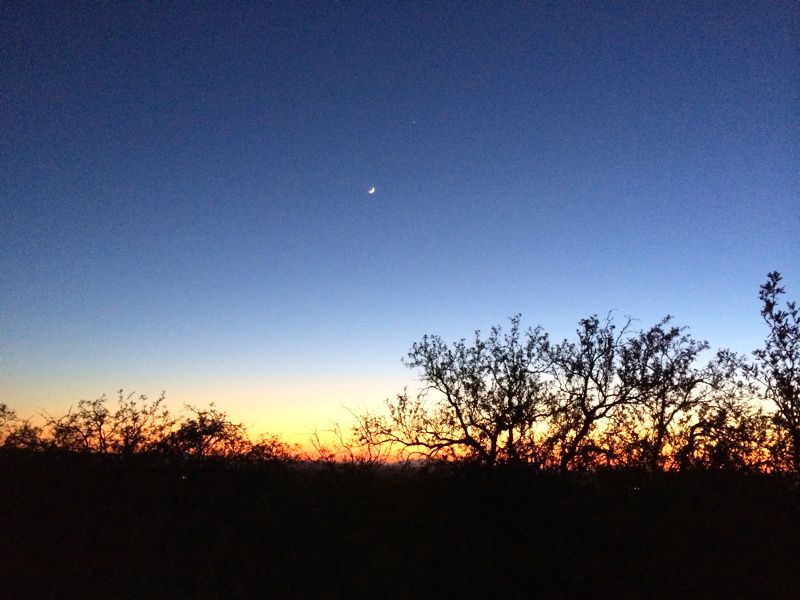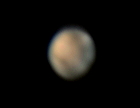
Imaging: Moon, Planets, Comet C/2012 K1,
Omega Centauri, Centaurus A, Kissing Bug
Posted: 1 June 2014
Monday, 26 May 2014, was clear so I went to Oracle State Park before sunset to get ready to do some more night sky photography and sky quality measurements. I was at the Park for over 7 hours. When I got home I was too tired to open the observatory. But I had a fun and worthwhile night at the Park. Clouds returned Tuesday, 27 May. And speaking of Oracle State Park, this Press Release was put out by Arizona State Parks on Thursday, 29 May. Shortly after the Press Release came out, I was interviewed by the Arizona Daily Star newspaper, which published the article "Oracle State Park seeks dark skies designation".
|
Opened: Saturday, 31 May 2014, 1821 MST Temperature: 109°F |
Session: 690 Conditions: Clear, breezy |
Upon opening the observatory, I first replaced a corrided AAA backup battery in the observatory clock and reset its time.
1834 MST: tried for Mercury, 83X, but didn't see it. Slewed to Sirius to check the eyepiece focus; refocused. Slewed back to Mercury; now visible in the center of the eyepiece field-of-view. The crescent phase was very obvious. Switched to 222X; still a nice view of the crescent phase. Mounted the iPhone 5s on the 8" telescope and did some afocal slo-mo video recordings (120 fps). This is a stack of 518 frames:

1851 MST: viewed the crescent moon, 83X. Its phase was nearly identical with Mercury's phase. This handheld iPhone afocal photo, 83X, was taken at 1858 MST (30 minutes before local sunset):

I then did some lunar observing, 83X. Mare Humboldtianum was clearly and totally in view due to lunar libration. 1928 MST: sunset. I also did lunar observing at 222X and 444X. The views at 444X were very good. This handheld iPhone 5s afocal photo, 444X, shows Mare Humboldtianum, and was taken at 1939 MST:

This iPhone 5s photo, taken at 1944 MST, shows the crescent moon and the 8" LX200-ACF telescope:

1950 MST: the moon was now too low observing using 444X. Switched to 222X; lots of very good details were visible inside Mare Humboldtianum.
Slewed to Jupiter and using 222X the four Galilean Moons were nicely aligned. This handheld iPhone afocal photo (cropped), 222X, was taken at 1956 MST:

This iPhone 5s photo, taken at 1958 MST, shows the crescent moon and Jupiter (up and right from the moon):

2009 MST: began observing Mars, 222X and 444X. The North Polar Cap and several dark areas were visible. This is a stack of 3526 slo-mo video frames, 666X + one Variable Polarizing Filter, taken at 2018 MST:

Resumed Mars observing, 444X, and also began preparing the D7000 DSLR for prime focus imaging on the 8" telescope. 2038 MST: last look at Mars.
Then did some Saturn observing, 444X. Three moons were visible: Titan, Dione, and Rhea. Using 222X, a fourth moon, Tethys, was visible. This is a stack of 3575 iPhone 5s slo-mo video frames, 666X, taken at 2057 MST:

I then set up for prime focus imaging. Added the f/6.3 focal reducer and mounted the D7000 DSLR on the 8" telescope using an off-axis guider. Did a focus test on the star Regulus using a Bahtinov Mask. I powered on the GC Wi-Fi Adapter and used SkySafari Pro to GOTO Comet 209P/LINEAR. Wow, it moved a lot from when I last imaged it on 21 May 2014. It was now very low in the southwestern sky. I tried imaging it but it was lost in the murk just above the horizon.
Slewed to Comet PanSTARRS C/2012 K1, which had also moved a lot since my last imaging (21 May 2014). The comet was barely visible in the camera viewfinder. This 3 minute, ISO 6400, unguided exposure was taken at 2144 MST, and is cropped from the full frame photo:

Just as I was completing comet imaging, I noticed that I had stepped on (and killed) the first Kissing Bug of the season. I really don't like Kissing Bugs. They are beetle-like insects about an inch long and they will suck your blood for up to 15 minutes.
Slewed to Omega Centauri, low in the southern sky, and took this unguided, 30 second, ISO 2000, photo:

Next, slewed to Centaurus A (galaxy). It was getting low in the southern sky. This is an unguided, 1 minute, ISO 6400, exposure, cropped from the full frame image:

2231 MST: ended imaging. 2242 MST: viewed Centaurus A galaxy, then Omega Centauri globular cluster. 2249 MST: took a last look at Saturn, 83X. Still four moons visible.
As I started maing preparations to close the observatory for the night, I saw another Kissing Bug. This one was still alive:

This Kissing Bug was terminated.
I then did some sky quality measurements using Dark Sky Meter Pro (iOS app) and a Unihedron SQM-L meter. I'm working with the DSM app developer to improve the apps calibration. The SQM-L reading was 21.32.
|
Closed: Saturday, 31 May 2014, 2315 MST Temperature: 75°F |
|
In other news I have replaced my old live view webcam with a new IP camera (no computer required). The image quality is much better. Check it out: Live Webcam.
Comments are welcome using Email. If you are on Twitter you can use the button below to tweet this report to your followers. Thanks.
Cassiopeia Observatory Home Page